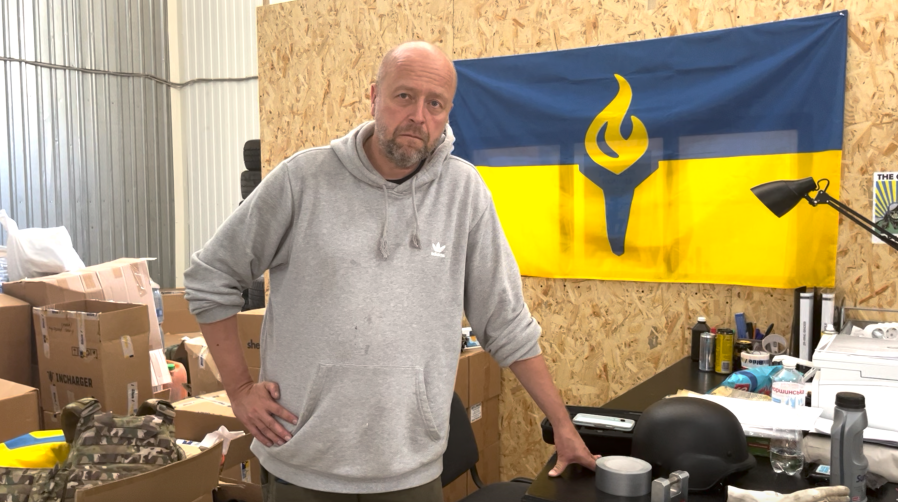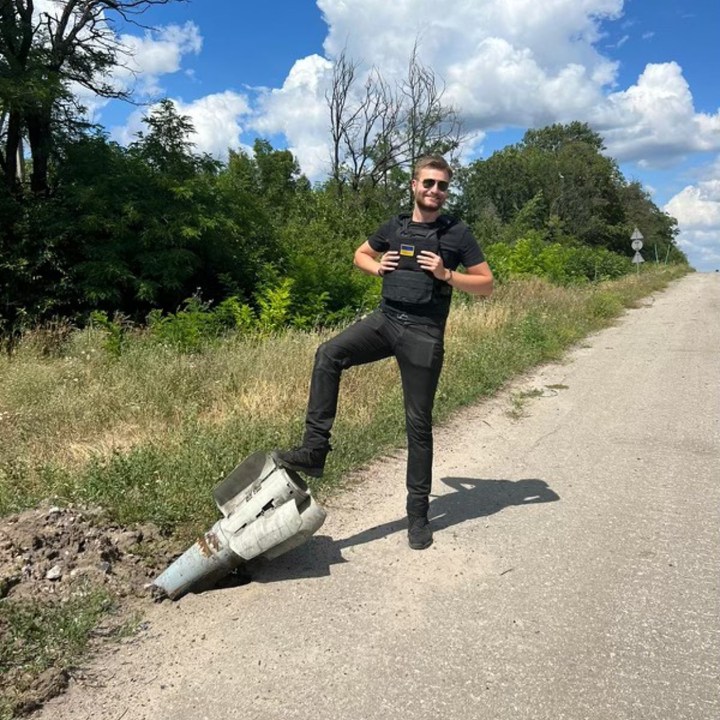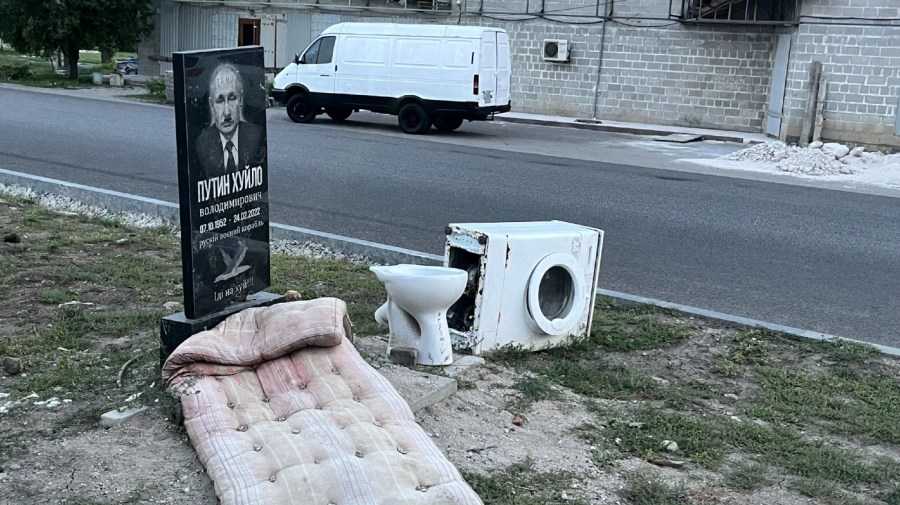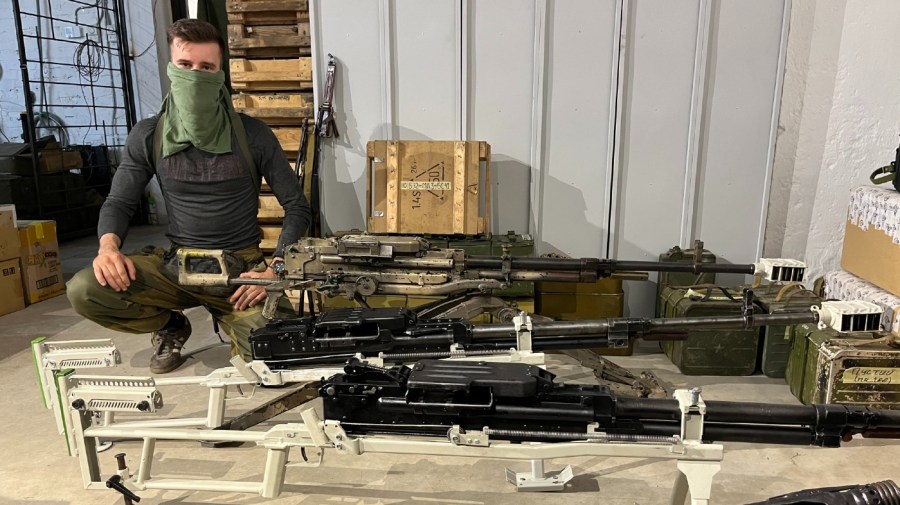WAR IN UKRAINE: Three nights with the volunteer force supplying the frontlines
It’s nearly 9 p.m. when the Ukrainian commander who calls himself “The Greek” brings our group to a makeshift workshop in the east of Ukraine, where soldiers are tinkering with improvised explosive devices.
The apparent head of the workshop, an engineer in his life before the war, welcomes us into a room that’s been repurposed from its original, civilian use — its exact description withheld for security purposes — but it looks distinctly like an arts and crafts center of death.
Materials for mixing explosives and their components, grenades and fuses with English-language descriptions, are all neatly organized on bookshelves and in see-through plastic containers that one would find in a kitchen or classroom.
The engineer is keen to talk to Jonas Öhman, the founder of the Blue/Yellow nongovernmental organization that, since 2014, has provided nonlethal support to Ukraine’s front-line troops — part of a volunteer force that has mushroomed since Russia’s invasion in February to keep Ukrainian forces fed, clothed, supplied and sane.
I traveled with Öhman, along with his colleague and driver, Gabrielius Merzinskis, over the course of three days — between Aug. 19 and 21 — visiting with Ukrainian military commanders holding the front line in the south and the east.

Jonas Öhman (Photo Laura Kelly)
DAY 1
6:30 p.m. — Heading out from Mykolaiv
The summer sun slowly sets over the vast expanse of grain and sunflower fields while we drive out of Mykolaiv to a small village in Ukraine’s southeast. There are few cars on the road, as most of the villages are abandoned, given the intensity of fighting.
Mykolaiv, a midsize city known for its port and shipbuilding industry, is a priority target for Russians, whose missiles are sent to destroy the city nearly every day.
We pull into an abandoned petrol station — it’s unclear if the damage is from the war or neglect, or maybe it is neglected from the war — and meet our escort.
Anatoly is a battalion commander who goes by the call sign “Chute,” an homage to his time in the paratroopers. Originally from the east, he’s an eight-year veteran of Russia’s war in the Donbas. His brigade was deployed to the area a few weeks earlier, and he met us driving a truck provided by Blue/Yellow. Öhman is relieved to see the vehicle still in commission, when so many things are being destroyed under Russian fire.
We’re sitting in a café away from the front line in the Kherson region, but the volley of artillery is audible. The line of contact is a few miles from our position. Anatoly explains that while the Russians are using their standard 122 mm and 152 mm artillery, the Ukrainians are answering with U.S.-provided M777 howitzers and High Mobility Artillery Rocket System.
All the lights are off except for those behind the bar. There are a few other patrons sitting at tables, but almost no conversation. Our hourlong conversation is slow, to account for the translation, and what little light was streaming through the window quickly fades.
At one point someone’s ringtone blares; it’s completely incongruous with the atmosphere and is quickly shut off — the whole point is to be invisible to possible Russian attacks.
Anatoly has agreed to speak with me about his experience at the front line as officials in Kyiv are pounding the drumbeat for a counteroffensive to retake Kherson — a strategic port city on the Dnieper River that fell in the first weeks of Russia’s invasion.
Anatoly looks exhausted. He orders tea. He has taken command of a battalion that includes a large number of recent military recruits, and their lack of experience is both worrisome and frustrating. Everyday, more soldiers are being wounded or killed.
The Ukrainians are making small advances, but the Russians forward artillery, while not accurate, is overwhelming in its stockpiles.
America and the west are providing “huge quantities” of weapons to Ukraine, but he appeals for “high-level, high-tech support.”
“What we are getting we’re very grateful for, it’s fantastic, obviously, but it helps to a certain level and we need to get beyond that level,” he says.
Öhman’s group has provided Anatoly’s battalion a Matrice 300 drone — a highly sophisticated reconnaissance drone that Anatoly says they launch behind enemy lines. The UAV has a ticket price of more than $10,000 and any loss is a defensive and financial hit. To combat Russian efforts to electronically disrupt its flight, the Ukrainians have rigged a low-tech solution, attaching fishing wire to the machine to reel it back in case of a problem.
Anatoly reels off a long list of additional materials needed to fight the war, and wants all of it to arrive faster.
“People are very motivated. If they get something, some new kind of weaponry, they basically go to YouTube, they teach themselves, and, I may say, in two, three days, most people can learn how to use them.”
It’s late when we finish. Öhman and Merzinskis leave Anatoly with a box of 10 helmets before we part ways. We have a long and dangerous drive ahead of us to reach Dnipro.

Gabrielius Merzinskis (Courtesy photo)
9 p.m. — The night drive
Merzinskis is driving us in a German-made, covered pickup truck, in which every available space is filled with donations to drop off at their warehouse in Dnipro.
If you ask Google Maps how to get to Dnipro, it will take you straight through Russian-controlled Kherson and the drive time is around seven hours.
Merzinskis does not drive through Kherson, but manages to accomplish the drive in five hours. It is a grueling ride on deeply pock-marked backroads that requires intensive swerving to avoid the larger holes and slowing down to ride over the more shallow ones.
Still, I managed to fall asleep, propped up by the donations piled around me. Öhman and Merzinskis wake me at around 2 a.m. We’ve arrived at our hotel in Dnipro.
DAY 2
Noon — Dnipro into Donetsk
Merzinskis has already unloaded the truck at Blue/Yellow’s warehouse — I’m relieved to have a little more space for what will end up being nine hours of travel later that night.
Öhman gives me a tour of the warehouse. Stockpiles range from energy drinks to tactical optics, backpacks organized as all-in-one medical kits and mobile fuel tanks.
He points out some souvenirs he’s received from grateful Ukrainian soldiers — Russian license plates, Soviet-era anti-tank missile launchers and World War II-era helmets he said the Russians are outfitting soldiers with to fight on the front lines.
Those soldiers are likely Ukrainian teenagers from the Russian-occupied territories, rounded up en masse, forcibly conscripted and sent to the front line without military training as cannon fodder.
4 p.m. — Heading out of Dnipro
We head out from Dnipro to start our night. The roads were better and military infrastructure more visible, in what has become a waystation for the front line. We pass one rest area where a number of trucks are parked and soldiers are sitting and drinking from disposable coffee cups.
My lunch that day consisted of a protein bar and some trail mix. Our dinner will come from a gas station on the way. Öhman keeps highly concentrated mineral water stocked in the warehouse. It tastes salty, but is supposed to be good for hydration.
They’ll make at least three stops tonight — two for delivery handoffs and one visit to the IED workshop.
Öhman has received rare permission from the Ukrainian Armed Forces to travel after sunset, when the rest of the country is under a government-imposed curfew — meant to keep civilians inside, streetlamps off and the roads empty, limiting the targets the Russians can identify for missile strikes. We have a security detail guiding us through the roads.
“It’s a good time to move around, but it’s also the time we have,” Öhman said.
“If you work during the day, you are open to the threat of civilians documenting you and spreading information. Darkness is a natural cover,” he said.
7:30 p.m.
The first handoff occurs on the side of the road in a small village in the east. In the middle of a traffic circle sits a fake headstone for Russian President Vladimir Putin, showing his date of death as Feb. 24, 2022, the day of invasion. Putin’s image is defaced with a mustache to resemble Hitler. A dirty mattress, toilet and broken washing machine are laid next to it.

Laura Kelly/The Hill
Öhman is meeting The Greek, whom he describes as a longtime contact, and Dmytro “Da Vinci” Kotsyubaylo, a veteran fighter from Ukraine’s volunteer militias — called “dobrebat” — who was recognized in January by Ukrainian President Volodymyr Zelensky with the Hero of Ukraine award, one of the highest distinctions provided by the state.
Da Vinci is a fighter from what’s been described as the ultra-nationalist Right Sector, one of the militias that make up Ukraine’s volunteer battalions. These dobrebat — some that originated with far-right ideologies — have assimilated into the military structure, and officials in Kyiv credit them as indispensable to the state’s defense.
Öhman hands over a few boxes of materials to The Greek and Da Vinci, including body armor, drones, batteries and some camping stoves and gas.
Öhman shows Da Vinci Blue/Yellow’s EOTech red dot sight — an optical rifle attachment that can provide night vision and thermal imaging optics on the battlefield.
The Greek expresses gratitude for U.S. military assistance, but wants a steadier flow of weapons and more Puma unmanned aerial systems — reconnaissance and surveillance drones — which have been delivered as part of the $13 billion in U.S. military assistance provided to Ukraine.
It’s from here that The Greek wants to introduce us to the engineer at the makeshift IED workshop. We’re on a tight schedule, but Öhman agrees.
When our group arrived at the workshop, about a dozen Ukrainian soldiers — many looking like they came directly from the front line — shuffled out of the room after sitting through a lesson provided by the engineer on different ways to build, hide and deliver explosives.
“Any object can kill,” the engineer tells our group, while pointing out the different options available for making explosives. There are palm-sized bombs to be dropped from drones, with small pellets wrapped around it with masking tape. A 3D printer is pumping out lightweight propellers to make it aerodynamic.
What appears to be a recovered 152 mm Russian artillery shell lies on its side against the wall, to be recycled by the engineer and turned back on the enemy.
The engineer is looking to source electronic parts from Öhman that can be used for the explosives. Öhman is noncommittal. He uses these front-line meetings to establish rapport and personally vet the people and requests on his donations list.
“This has taken a turn, they have boosted production,” Öhman says as we walk out of the building. “This is a major development in terms of IED capacity.”
10 p.m.
We’re back on the road, driving to deliver to Ukrainian medics five medical stretchers at about $100 a pop. The stretchers are lightweight and compact and can be stored in any front-line military vehicle to allow for quick evacuation of injured soldiers, Öhman says.
Distant explosions periodically light up the pitch-black night during the two-hour drive, but the front line appears far enough away to feel some sense of safety.
We drive through totally blacked-out villages and along the more secluded roads that are obstructed with concrete road blocks and tank busters — steel beams crisscrossed to obstruct the roadway. Merzinskis veers through this maze at high speed — both to account for the long drive and avoid potential Russian strikes.
We pass over a bridge where all the street lights are off and pull into what appears to be a small city, but feels like a ghost town, with buildings dark and lifeless.
We arrive at our rendezvous point near the Ukrainian-controlled village of Kramatorsk.

The remains of the destroyed School Number 23 are seen at dusk after a Russian attack that occurred in the second half of July, in Kramatorsk, Ukraine, Aug. 27, 2022. (AP Photo/Leo Correa)
In the quiet moments while we wait, I look up to the sky and take a moment to appreciate the blanket of stars — only visible because life on the ground is plunged into darkness.
The medics arrive in their ambulance. Maxim, a first responder, introduces himself in broken English. He’s been in the war for nearly five months and explains that his ambulance — himself, a nurse and a driver — is one of five evacuation teams working on the front line.
Inside the ambulance, some children’s drawings offer a pop of life and color to the sanitized medical equipment. But Maxim also shows me photos on his cellphone of the ambulance covered in blood — pooled and spattered on the floor and walls.
“We have many who need this,” he says, referring to the stretchers. “Many different situations can be in this war.” His team wants to put a portable stretcher in each armored personnel carrier so that, if attacked by the Russians, it can help with evacuating the wounded.
This was Öhman’s first time meeting the medics, and he said it was important to do it face-to-face.
“How we’re working, it’s a lot of personal relationships and making personal connections,” he said.
DAY 3
3 p.m. — Kharkiv to Kyiv
We arrived in Kharkiv, Ukraine’s second largest city, Sunday afternoon.
The morning had been surreal. After arriving at a different hotel in Dnipro around 1 a.m., I got a decent night’s sleep and in the morning took stock of the German-Bavarian riverside vacation retreat where we had landed. Breakfast was served in the sunshine along the water in individual gazebos. It was like we were enjoying an all inclusive trip — and then we were back on the road.
The drive to Kharkiv was about three hours, and we’d spend only three hours in the city, which has fiercely resisted a Russian takeover, with the border roughly 30 miles away.
It feels cosmopolitan and somewhat lively despite the signs of Russia’s attacks. We pass a shopping mall with the glass windows blown out and shops boarded up after a rocket strike.
Öhman directs us to an empty parking lot to hand over helmets to a Ukrainian brigade commander, who declines to be interviewed but lets out a “Super!” when he sees the quality of helmets.
He invites us for lunch at a building serving as their headquarters. Baked catfish, cured meats and traditional Ukrainian coleslaw salad are on the table. We’re served homemade borscht, lard on toast with pickles, and rice and meat.
The conversation takes place largely in Russian and Ukrainian and I’m offered little translation, except for one anecdote from the commander. He describes speaking with an older woman in a recently liberated Ukrainian village in the south who said Russian soldiers were incredulous at Ukrainians’ basic amenities, like a fence for their yard.
“‘Who gave you permission to live like this?’” the soldier asked the woman, per the commander’s telling, and he shakes his head.
The next stop was a repurposed office building that is the headquarters of the Freikops, a dobrebat but that coordinates closely with Ukrainian forces.
The building could house a tech startup, with graffiti art on the walls, an open floor plan, and snooker and a ping-pong table in the center of the room.
A few of the soldiers are on leave from the front for a week of rest and training. They sleep on stacked mattresses in the basement, with some curtains strewn up for privacy. Next to the sleeping quarters is the weapons arsenal — rifles with their call signs stacked in the corner.

Laura Kelly/The Hill
Makar, the 26-year-old commander of the unit, shows off a stockpile of seized Russian weapons, including a Kalashnikov machine gun. Some of these weapons are being repurposed for use by the Ukrainians, but are largely trophies from the battlefield.
The visit was supposed to give me a chance to get a sense of the front lines through those leading the fight, but Makar can say little about what the unit is doing operationally. He mentions that the morale of the soldiers is high, but they are also speaking with military psychologists to deal with post-traumatic stress from the battles.
6 p.m.
We begin the seven-hour drive to Kyiv, where I’ll leave Blue/Yellow. Around 10 p.m., and about an hour outside of Kyiv, we drive over a brightly lit bridge. All the street lamps are on. It’s a jarring contrast to the darkness of the past few nights.
Copyright 2023 Nexstar Media Inc. All rights reserved. This material may not be published, broadcast, rewritten, or redistributed.

